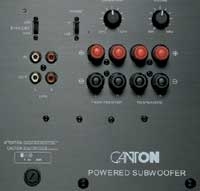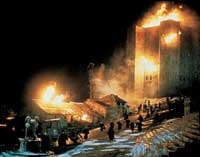Canton CD 300 Home Theater Speaker System Page 2
 Canton calls the driver layout in both the towers and center/surrounds a "two-and-a-half-way" system. Each cabinet contains four 4-inch aluminum-cone drivers and an aluminum-manganese dome tweeter. The tweeter's dome and voice coil are manufactured as a single unit rather than being glued together, which is said to make the moving mass stiffer, lighter, and better at dissipating heat. Two of the cones reproduce only bass, while the other two share midrange and bass duties. Canton claims this array provides output equivalent to an 8-inch driver in a much narrower cabinet. The main difference between the CD 300 towers and the CD 360 F center/surrounds besides length (the drivers are identical) is that the towers are ported while the others are sealed.
Canton calls the driver layout in both the towers and center/surrounds a "two-and-a-half-way" system. Each cabinet contains four 4-inch aluminum-cone drivers and an aluminum-manganese dome tweeter. The tweeter's dome and voice coil are manufactured as a single unit rather than being glued together, which is said to make the moving mass stiffer, lighter, and better at dissipating heat. Two of the cones reproduce only bass, while the other two share midrange and bass duties. Canton claims this array provides output equivalent to an 8-inch driver in a much narrower cabinet. The main difference between the CD 300 towers and the CD 360 F center/surrounds besides length (the drivers are identical) is that the towers are ported while the others are sealed.
The downward-firing subwoofer offers both line- and speaker-level inputs as well as a two-position phase switch and crossover-frequency and level controls. I used the line-level subwoofer output from my Denon receiver, bypassing the sub's crossover.
 |
| The Canton speakers handled the soundtrack of The Name of the Rose with the same authority Sean Connery's William of Baskerville character displays in solving the mystery. |
MOVIE PERFORMANCE I journeyed back to the Middle Ages to test the 21st-century Canton system with a recent DVD of The Name of the Rose , the movie based on Umberto Ecco's novel of medieval skullduggery and philosophical ruminations. Director Jean-Jacques Annaud matches the dim, deliberately shadowy images with a growling soundtrack - which was remixed for Dolby Digital 5.1 - featuring a musical score that rises and falls in deep, primal, low-frequency waves.
The Canton system faithfully reproduced the sounds of heavy cartwheels rolling, large chains coiling and uncoiling, beefy men ponderously walking, and huge wooden doors closing with a thud. Bass-heavy sounds came across firmly, from the thunderous opening of the monastery gates to the climactic roaring inferno as the library burned. The hammering of the blacksmith in the courtyard and the rattling-clanking of the condemned prisoners' chains as they stumbled toward the stakes sounded grimly realistic.
Indeed, the CD 300 system, which can play at very high volumes, handled the soundtrack with as much authority as Sean Connery's William of Baskerville character displays in solving the mystery. Reverberation and echoes accompanied much of the dialogue, yet the speakers clearly conveyed every word, including the barely comprehensible mix of languages used by the crazed monk Salvatore. Most impressive were the scenes where the monks assembled to sing Gregorian chants. The fullness and depth turned my home theater into a cathedral.
I went from the sublime to the ridiculous with a blast from the folk-music sendup A Mighty Wind . The Canton system lacked the treble sparkle I often notice with this kind of material. The banjo sounded clean and present, but not briskly crisp. In my 15 x 24-foot room, the upper bass was also mildly pronounced, but not enough to detract from my enjoyment.
While the Canton system reproduced all the ambience recorded on the soundtracks, in my room I heard the sound as coming from individual speakers rather than a wide, seamless sound field. Moving the front L/R speakers a bit further apart and angling them slightly toward the listening position helped spread the sound.
MUSIC PERFORMANCE For pure audio, I returned to the Name of the Rose era with Philip Pickett conducting the New London Consort in the original Carmina Burana , not Carl Orff's modern setting. The Canton system brought me back to many an enjoyable Sunday listening to medieval music at the Cloisters museum in New York City . This stereo recording filled the apse of my listening room.
|
For multichannel music I spun the Super Audio CD of James Taylor's Hourglass . This mellow recording, with Taylor 's mellifluous voice and Yo-Yo Ma's even sweeter cello, poured smoothly from the Cantons. I could sense the tension on the drumheads as they reported from the speakers with notable tightness. Frank Filipetti's six-channel mix - with Taylor's voice in the center, the main instruments in the left and right front channels, some harmonies and percussion in the surrounds, and deep bass in the subwoofer - was well served by this system. What I missed most was an overall feeling of airiness and openness.
BOTTOM LINE While I have minor quibbles about tonal balances and airiness, overall these speakers beg you to bring it on. They can transport you smoothly from 13th-century instruments to 21st-century pop while doing justice to both - and provide the visceral effects of whatever movie you choose. If you like your sound larger than life, this Canton system aims to please. And it looks stunning.













































